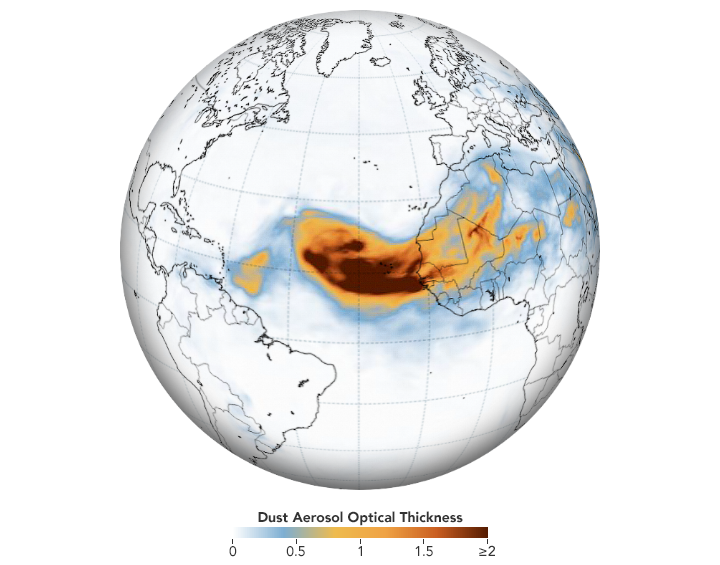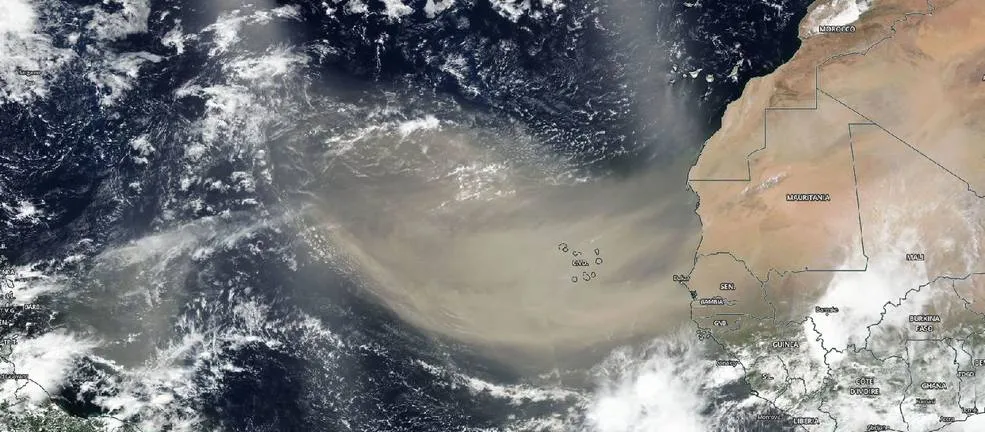Huge Saharan Dust Cloud Could Bring Hazy Skies, Spectacular Sunsets to the United States
The large dust cloud has already obscured skies in the Caribbean and will likely reach Gulf Coast states by the middle of this week
/https://tf-cmsv2-smithsonianmag-media.s3.amazonaws.com/filer/96/9b/969b6c6d-e1f0-4179-a30a-2b165c2b5400/gif_of_saharan_dust_blowing_west_seen_from_satellite.gif)
An enormous plume of dust from the Saharan desert has blown 5,000 miles across the Atlantic Ocean and will likely reach the Gulf Coast by the middle of this week, according to the National Oceanic and Atmospheric Administration (NOAA).
Every year, winds carry about 800 million metric tons of dust from North Africa across the Atlantic coast, a phenomenon known as the Saharan Air Layer, according to a statement from NASA’s Earth Observatory. So this plume isn’t altogether unusual—but “the size and visible impact of this particular plume makes it stand out,” reports Amanda Kooser for CNET.
The plume is clearly visible from space. NASA satellite images taken on June 18 showed that the expanse of dust stretched about 1,500 miles across the Atlantic Ocean, according to the statement.
On Sunday, NASA astronaut Doug Hurley posted a photo of the plume as seen from the International Space Station to Twitter. “We flew over this Saharan dust plume today in the west central Atlantic. Amazing how large an area it covers!” Hurley says.
We flew over this Saharan dust plume today in the west central Atlantic. Amazing how large an area it covers! pic.twitter.com/JVGyo8LAXI
— Col. Doug Hurley (@Astro_Doug) June 21, 2020
“Large plumes of Saharan Dust routinely track into the Atlantic Ocean from late spring into early fall,” meteorologist Haley Brink tells Judson Jones of CNN. “Every so often, when the dust plume is large enough and trade winds set up just right, the dust can travel thousands of miles across the Atlantic and into the US.”
CNN meteorologist Tyler Mauldin says that the most noticeable thing about the plume from the ground will be how it changes the sky, giving it a “milky haze.” In the Caribbean, residents have already started to witness darkened, murky skies and “hazardous” air quality, Dánica Coto reports for the Associated Press. Public health officials in Puerto Rico are worried about how the extra air pollution will affect patients battling respiratory problems related to COVID-19 and have urged residents to stay indoors and use air filters if possible, reports Coto.
While the dust particles might soften the blue of the sky during the day, they will also likely make for spectacular sunsets. The dust will float into the U.S. at altitudes of 30,000 to 50,000 feet. “The dust will be primarily at higher altitudes, so the main impact will be some especially colorful sunrises sunsets,” the National Weather Service notes in a Tweet.
A computer model forecast of atmospheric dust for the next 10 days. The plume of Saharan dust is expected to move over the Southeastern US next week. The dust will be primarily at higher altitudes, so the main impact will be some especially colorful sunrises sunsets pic.twitter.com/bBzFp06lCu
— NWS Eastern Region (@NWSEastern) June 19, 2020
“Due to more sunlight being scattered by the dust particles, there will likely be more vibrant sunsets and sunrises of the orange and red side of the visible light spectrum,” David Wally, a National Weather Service meteorologist, tells Johnny Diaz of the New York Times.
The dry, dusty wind could also potentially suppress tropical cyclones by lowering humidity levels and limiting the formation of clouds, Wally tells the Times. This unusually large plume of dust could impact this season’s storms, although it’s still early in hurricane season, which typically runs June 1 through November 30.
An increase in small particles in the air might also trigger dust-related allergies for those exposed, according to Mauldin for CNN. Although they will likely blow into the U.S. at high altitudes, some tiny dust particles will make their way to the surface and could be irritating, especially for those with respiratory problems or asthma.
Dust from North Africa plays a key ecological role in North and South America, according to the NASA statement. The particles can fertilize soils in the Amazon rainforest and shore up beaches in the Caribbean.
/https://tf-cmsv2-smithsonianmag-media.s3.amazonaws.com/accounts/headshot/nora.png)


/https://tf-cmsv2-smithsonianmag-media.s3.amazonaws.com/accounts/headshot/nora.png)